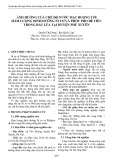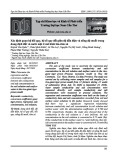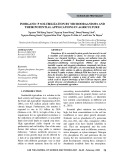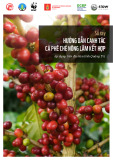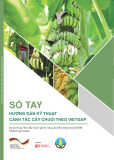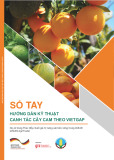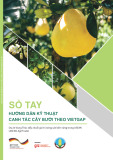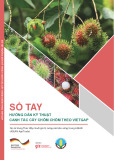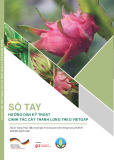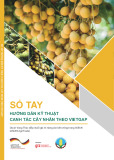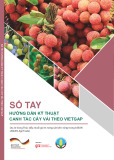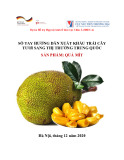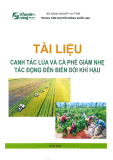
Vietnam Journal
of Agricultural
Sciences
ISSN 2588-1299
VJAS 2024; 7(3): 2195-2207
https://doi.org/10.31817/vjas.2024.7.3.02
https://vjas.vnua.edu.vn/
2195
Received: June 9, 2024
Accepted: September 24, 2024
Correspondence to
esiosaadewale@gmail.com
ORCID
Esiosa Adewale
https://orcid.org/0000-0002-0513-
6009
Investigating the Influence of Inorganic and
Organic Fertilizers on the Growth and Yield
of Three Varieties of Okra (Abelmoschus
esculentus)
Esiosa F. Adewale1*, Andrew A. Efisue2 & Caleb I. Adewale3
1Department of Plant Science and Biotechnology, Faculty of Science, University of Port
Harcourt, PMB 5323, Port Harcourt, Nigeria
2Department of Crop Science, Faculty of Agriculture, University of Port Harcourt, PMB
5323, Port Harcourt, Nigeria
3Department of Rural Development and Agribusiness, Faculty of Agriculture and
Environment, Gulu University, P.O Box 166, Gulu, Uganda
Abstract
Fertilizers play an important role in enhancing crop yield, plant
growth, and the fertility of the soil. This research was conducted at the
Faculty of Agriculture Teaching and Research Farm, University of
Port Harcourt, Nigeria to investigate the influence of inorganic
fertilizer (urea) and organic manure (spent mushroom substrate and
poultry manure) on the yield and growth parameters of three okra
cultivars (Clemson Spineless, Perkins Long Pod, and a local assertion).
The treatments were 4.0g of urea, 150g and 200g of poultry manure,
150g and 200g of spent mushroom substrate, and a control treatment
(no fertilizer), and were laid in a completely randomized design (CRD)
with three replications. The results revealed that the okra cultivars
responded positively to both organic manures when compared with
urea and the control group. Poultry manure significantly enhanced the
growth and yield parameters across all varieties, with Perkins Long
Pod exhibiting the highest performance. The highest plant height
(62.77cm) was observed in Perkins Long Pod with 150g of poultry
manure, while Clemson Spineless and the local variety reached 42.5cm
and 44.77cm, respectively, with 200g of spent mushroom substrate.
Urea application led to the maximum leaf area (123.7 cm²) and leaf
area index (0.085) in Clemson Spineless. Fruit yield was the highest in
the local variety with 200g of poultry manure, achieving 967.8 kg ha-
1, followed closely by 200g of spent mushroom substrate at 945.9 kg
ha-1. The study concluded that the Perkins Long Pod variety and
poultry manure are the most suitable for maximizing okra yield in
tropical environments.
Keywords
Okra, Abelmoschus esculentus, Organic and inorganic fertilizers,
Yield

Investigating the influence of inorganic and organic fertilizers on the growth and yield of three varieties of Okra
2196
Vietnam Journal of Agricultural Sciences
Introduction
Okra (Abelmoschus esculentus) is a widely
cultivated vegetable in Nigeria and some tropical
and sub-tropical countries. Okra is a member of
the Abelmoschus genus and species esculentus of
the Malvaceae family (Linnaeus, 1753). It is
particularly cherished in Nigeria for its
mucilaginous attributes (Benchasri, 2012). The
primary focus of cultivating okra is its edible
"pods," commonly prepared and consumed in
African nations such as Nigeria, Egypt, and
Sudan. Notably, the mucilaginous substance
derived from okra has been employed to treat
ulcers, alleviate hemorrhoids, and aid in sugar
processing as a cleansing agent (Petropoulos et
al., 2018; Chand et al., 2024). The tender pods of
okra contain essential vitamins including A, C,
and traces of B vitamins (Dorni et al., 2017).
Beyond its culinary merits, okra is a valuable
source of calcium, contributing to strengthening
bones and preventing fractures, along with other
nutrients promoting overall health (Agregán et al.,
2023). Interestingly, the seeds of okra can be
roasted and used as a coffee substitute. This
vegetable has historically been a dietary staple for
many, particularly among rural communities and
those with limited incomes in tropical and
subtropical regions, including Nigeria (Gloria et
al., 2017). Satisfying the nutritional demands of
okra during its growth and development requires
careful attention to the diverse elements supplied
by fertilizers. However, fertilizers vary in their
concentrations of the essential nutrients necessary
for optimal plant growth (Singh et al., 2013).
Maintaining soil productivity poses a
significant challenge for tropical farmers (Jat et
al., 2012). Traditionally, farmers have shifted
crop cultivation across fields to capitalize on
fertile soils, avoiding the use of fertilizers.
However, this approach is no longer sustainable
to meet the rising demands of a growing
population (Jayne et al., 2014). Soils in tropical
regions suffer from compromised fertility and
erosion, leading to nutrient depletion and shifts
in soil organism populations. While inorganic
fertilizers can boost crop yields and enhance soil
characteristics like pH, nutrient content, and
availability, their use is constrained by factors
such as scarcity, expense, nutrient imbalances,
and soil acidity (Uka et al., 2013). To address
these challenges, the application of organic
manure has been proposed as a strategy to uphold
and enhance soil fertility (Timsina, 2018; Cai et
al., 2019). Efficient utilization of animal
manures sustains long-term crop productivity by
immobilizing nutrients prone to leaching.
Nutrients within these manures are gradually
released and retained in the soil for extended
periods, resulting in lasting effects that foster
improved root growth and heightened crop yields
(Rayne & Aula, 2020). Manure is typically
administered at higher rates compared to
inorganic fertilizers. When used in substantial
amounts, they yield residual benefits for
subsequent crop growth and yield (Makinde &
Ayoola, 2012; Timsina, 2018). According to
Hoang et al. (2023), using organic fertilizer
under stringent principles results in healthy and
environmentally friendly agricultural produce.
Consequently, animal waste, which can be
transformed into organic manure has emerged as
a preferable and necessary alternative for
enhancing okra production, particularly in
tropical regions. The inclusion of organic
fertilizers is imperative due to their abundant
nutrient contents, user-friendly handling, and
straightforward application. However, regarding
quantity, the volume of poultry manure needed
for cultivation is lower than that of cow, goat, and
sheep manure (Okorogbona & Adebisi, 2012).
Small-scale farmers benefit from reduced
production costs as poultry manure tends to be
more economical than NPK or urea fertilizers. In
the context of Nigeria, hindrances to successful
okra production and the cultivation of other
vegetables include weed management,
appropriate tillage practices, utilization of low-
yield varieties, and sub-optimal planting density
as well as soil fertility (Lyagba et al., 2012).
Due to variations in fertilizer concentrations,
the growth rate and yield of plants can differ
significantly locally and across different regions
depending on soil conditions and other
characteristics (Belete et al., 2018). Hence, there
is a compelling requirement to explore and
analyze the impacts of varying levels of both

Esiosa et al. (2024)
https://vjas.vnua.edu.vn/
2197
inorganic and organic fertilizers on the growth
and yield of okra particularly in the southern part
of Nigeria. Furthermore, previous studies on okra
cultivation have predominantly focused on the
influence of organic and/or inorganic fertilizers
on the growth and yield of a single variety of okra
(Atijegbe et al., 2014; Khandaker et al., 2017;
Aluko et al., 2020, Unagwu et al., 2021; Kumar
et al., 2023). This narrow focus has left a
significant gap in understanding how these
fertilizers interact with different okra varieties
under controlled conditions. Our study aimed to
fill this gap by investigating the effects of organic
(poultry manure and spent mushroom substrate)
and inorganic (urea) fertilizers on the growth and
yield of multiple okra varieties. Specifically, this
study sought to identify an ideal variety and the
possible integration of organic and inorganic
fertilizers that would give optimum yields of
Clemson Spineless, Perkins Long Pod, and a
local variety of okra, and analyze the
performance and effects of urea, poultry manure,
and spent mushroom substrate on each of the
varieties listed above. By employing a
comprehensive approach that integrated multiple
fertilizer types and okra varieties, our research
provides novel insights into optimizing okra
production and thereby contributing to more
sustainable and efficient agricultural practices.
Materials and Methods
Sources of materials
The okra varieties utilized in the study
included known varieties and a local variety. The
known varieties, Clemson Spineless and Perkins
Long Pod were sourced from Agrotropic Ltd. in
Rivers State, Nigeria. Clemson Spineless is
renowned for its spineless pods, making them
easier to handle and harvest, while the Perkins
Long Pod variety is distinguished by its
elongated pods and high yield potential. The
local variety of okra was obtained from the
Ogoni community in Rivers State, Nigeria, and is
known for its adaptability to the local climate and
soil conditions.
The fertilizers used in the study were urea,
poultry manure, and spent mushroom substrate,
all sourced from the Faculty of Agriculture
Teaching and Demonstration Farm at the
University of Port Harcourt, Nigeria. Urea is a
nitrogen-rich synthetic fertilizer widely used for
promoting vigorous plant growth. Poultry
manure is an organic fertilizer rich in essential
nutrients like nitrogen, phosphorus, and
potassium, and is beneficial for improving soil
fertility and structure. Spent mushroom
substrate, a by-product of mushroom cultivation,
is rich in organic matter and nutrients and is used
in enhancing soil health and promoting
sustainable agricultural practices.
Experimental design and treatments
A potted experiment was conducted at the
University of Port Harcourt Teaching and
Research Farm in Nigeria from June to September
2019. Before the experiment was carried out, soil
samples were collected and analyzed for pH, soil
organic matter, and the presence of essential
nutrients including nitrogen, phosphorus, and
potassium. The study employed a two-factor
experiment in a completely randomized design
(CRD). Factor A was the okra cultivars (Clemson
Spineless, Perkins Long Pod, and a local
assertion), and Factor B was the fertilizer
treatments (urea, poultry manure, spent
mushroom substrate, and a control). Six fertilizer
treatments, namely 4grams of urea, 150grams of
poultry manure, 200grams of poultry manure,
150grams of spent mushroom substrate, 200grams
of spent mushroom substrate, and a control
treatment with no fertilizer application, were
applied to each cultivar, with three replications per
treatment. This design allowed for the assessment
of different fertilizer treatments on the growth and
yield of okra, providing a comprehensive
comparison of their effects under controlled
conditions.
Sowing, treatments, and intercultural
practices
Okra seeds were soaked in water for about
2 hours before planting to break the seed
dormancy and help speed up the germination
process. Fifty-four (54) bags 40-45cm in width
were filled with 10kg of sterilized soil and
perforated to ensure proper aeration and
drainage. Seeds were sown directly into the soil

Investigating the influence of inorganic and organic fertilizers on the growth and yield of three varieties of Okra
2198
Vietnam Journal of Agricultural Sciences
at the rate of four seeds per hole at a depth of
1.5cm. This was later thinned to one plant per
bag. Twenty-eight (28) days after planting
(seedling stage), the treatments were applied
(poultry manure, urea, and spent mushroom
substrate) using the ring method of application.
The bags were kept free from weed infestation
and irrigation was carried out when required.
Harvesting
At 56 days after planting, fruiting and
harvesting started. The pods were carefully
harvested by hand using a sharp knife to avoid
injuring the plants. Harvesting was done once
a week for three weeks.
Collection of data
Measurements commenced three weeks after
planting (3 WAP) and continued at weekly
intervals. Data collection focused on both the
growth and yield parameters of okra. The growth
parameters were plant height, number of leaves,
leaf area, and leaf area index. The yield
parameters encompassed the number of fruits per
plant, fresh weight of fruits per plant, total fruit
yield per variety, fruit length, and fruit diameter
per plant. Plant height was measured using a
wooden meter ruler from the base of the plant
above the ground to the tip of the highest leaf.
The number of leaves was determined by visually
counting the leaves on each plant, excluding the
young leaves at the growing point. The number
of fruits was recorded by counting the fresh fruits
harvested from each plant. Fruit length and
diameter were measured using a meter ruler and
a caliper, respectively. The fresh weight of the
fruits was measured in grams using an electric-
sensitive scale. Leaf area was calculated by
recording the length and width of a leaf from
each plant and applying the formula: Leaf Area
= Length * Width * 0.75. Fruit yield (kg ha-1) was
calculated using the formula: Fruit Yield =
(Fresh Weight * 10,000) / Land Area. The leaf
area index (LAI) was determined by taking the
average leaf area from each treatment level and
using the formula: LAI = Leaf Area / Land Area.
These measurements provided a comprehensive
assessment of the okra plants' growth and yields
under different treatment conditions.
Statistical analysis
Data collected for each parameter were
recorded and subjected to analysis of variance
(ANOVA) using SPSS 25.0, and the means were
separated using the least significant difference
(LSD) test at the P ≤0.05 probability level.
Results
Plant Height
The effects of urea, poultry manure, and
spent mushroom substrate on the plant height
of the okra varieties are shown in Figure 1.
There were differences in the mean plant
heights after the treatment applications and the
results also showed that plant height was
influenced by varietal differences. The Perkins
Long Pod variety produced taller plants,
followed by the local assertion and Clemson
Spineless. At 10 weeks, the highest plant
height (62.77cm) was found in the poultry
manure 150g treatment for Perkins Long Pod,
while the highest plant heights for Clemson
Spineless (42.5cm) and the local assertion
(44.77cm) were found in the spent mushroom
substrate 200g treatment. For the Perkins Long
Pod variety, spent mushroom substrate 200g
had the second highest height (56.5cm),
followed by poultry manure 200g (54.03cm),
which was not significantly different from
those of urea 4g (52.7cm) and the control
(49.8cm), and the shortest height was found in
spent mushroom substrate 150g (46.27cm).
The second highest plant height for Clemson
Spineless was recorded in spent mushroom
substrate 150g (41.1cm), followed by urea 4g
(38cm), poultry manure 200g (35cm), and
poultry manure 150g (33.5cm), and the shortest
height was found in the control (31.7cm). For
the local assertion, the second highest plant
height was found in poultry manure 200g
(44.75cm), followed by spent mushroom
substrate 150g (40.2cm), poultry manure 150g
(31cm), and urea 4g (29.33cm), with the
control having the shortest height (28.23cm).
Number of Leaves
The results of the effects of urea, poultry
manure, and spent mushroom substrate on the

Esiosa et al. (2024)
https://vjas.vnua.edu.vn/
2199
number of leaves are shown in Figure 2.
Applying 4g of urea 10 weeks after planting
produced a higher number of leaves (9.3) for the
Perkins Long Pod variety, followed by poultry
manure 200g (8), and spent mushroom substrate
200g (7.3). There were no differences among the
number of leaves of spent mushroom substrate
150g, poultry manure 150g, and the control,
which had the least number of leaves (7). For
Clemson Spineless, the highest number of leaves
was recorded in poultry manure 200g (7), there
were no significant differences among the
number of leaves of urea 4g (6.5), poultry
manure 150g (6.5), and spent mushroom
substrate 150g (6.5). The least number of leaves
was observed in spent mushroom substrate 200g
(5). The highest number of leaves for the local
assertion was found in urea 4g (7.7), which was
not statistically different from that of spent
mushroom substrate 150g (7.5) or poultry
manure 200g (7). The fewest numbers of leaves
were found in spent mushroom substrate 200g
(5.5) and poultry manure 150g (5.5), which were
not different from the control (6).
Note: *P.M Poultry Manure *SMS – Spent Mushroom Substrate *Means of each bar followed by the same letters are not significantly
different at the LSD P ≤0.05 probability level within cultivars and across treatments.
Figure 1:
Effect of Nitrogen Source on Plant Height
Note: *P.M Poultry Manure *SMS – Spent Mushroom Substrate *Means of each bar followed by the same letters are not significantly
different at the LSD P ≤0.05 probability level within cultivars and across treatments.
Figure 2:
Effect of Nitrogen Source on the Number of Leaves
a
baa
bb
cc
d
c
bc
c
aaa
bbb
0.00
10.00
20.00
30.00
40.00
50.00
60.00
70.00
Control Urea (4g) P.M (150g) P.M (200g) SMS (150g) SMS (200g)
Plant Height (cm)
Treatment
Clemson Spineless Perkins Long Pod Local Assertion
a
b b bb
a
b
d
b
c
bc c
a
bc
a
bbc
a
0.00
2.00
4.00
6.00
8.00
10.00
12.00
Control Urea (4g) P.M (150g) P.M (200g) SMS (150g) SMS (200g)
Number of Leaves
Treatment
Clemson Spineless Perkins Long Pod Local Assertion








